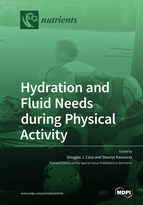Hydration and Fluid Needs during Physical Activity
A special issue of Nutrients (ISSN 2072-6643). This special issue belongs to the section "Sports Nutrition".
Deadline for manuscript submissions: closed (15 April 2021) | Viewed by 52586
Special Issue Editors
Interests: hydration; exercise in heat; thermoregulation; heat stroke; maximizing performance in the heat
Special Issues, Collections and Topics in MDPI journals
Interests: water intake and glucose homeostasis; hydration and childhood obesity; fluid and electrolyte balance during exercise; hydration assessment and biomarkers; hydration and cardiovascular health
Special Issue Information
Dear Colleagues,
We are excited to announce a Special Issue in the journal of Nutrients that will focus on Hydration during Physical Activity. This Special Issue will specifically address a variety of hydration topics related to the performance, health, heat exposure, safety, recovery, physiology. and other factors that are influenced when fluid balance is altered during physical activity. Our aim is to bring together hydration experts from around the globe, and we hope that you will consider submitting recent data you have compiled that can contribute to the collection of articles in this Special Issue. We encourage outside-the-box concepts, ideas, methodologies, and questions that can invigorate the discussion of this vital topic that has such a huge impact on hundreds of millions of laborers, warfighters, athletes, and recreationally active individuals around the world.
Prof. Dr. Douglas J. Casa
Prof. Dr. Stavros Kavouras
Guest Editors
Manuscript Submission Information
Manuscripts should be submitted online at www.mdpi.com by registering and logging in to this website. Once you are registered, click here to go to the submission form. Manuscripts can be submitted until the deadline. All submissions that pass pre-check are peer-reviewed. Accepted papers will be published continuously in the journal (as soon as accepted) and will be listed together on the special issue website. Research articles, review articles as well as short communications are invited. For planned papers, a title and short abstract (about 100 words) can be sent to the Editorial Office for announcement on this website.
Submitted manuscripts should not have been published previously, nor be under consideration for publication elsewhere (except conference proceedings papers). All manuscripts are thoroughly refereed through a single-blind peer-review process. A guide for authors and other relevant information for submission of manuscripts is available on the Instructions for Authors page. Nutrients is an international peer-reviewed open access semimonthly journal published by MDPI.
Please visit the Instructions for Authors page before submitting a manuscript. The Article Processing Charge (APC) for publication in this open access journal is 2900 CHF (Swiss Francs). Submitted papers should be well formatted and use good English. Authors may use MDPI's English editing service prior to publication or during author revisions.
Keywords
- Hydration status
- Hydration and performance
- Hydration and thermoregulation
- Hydration and health








